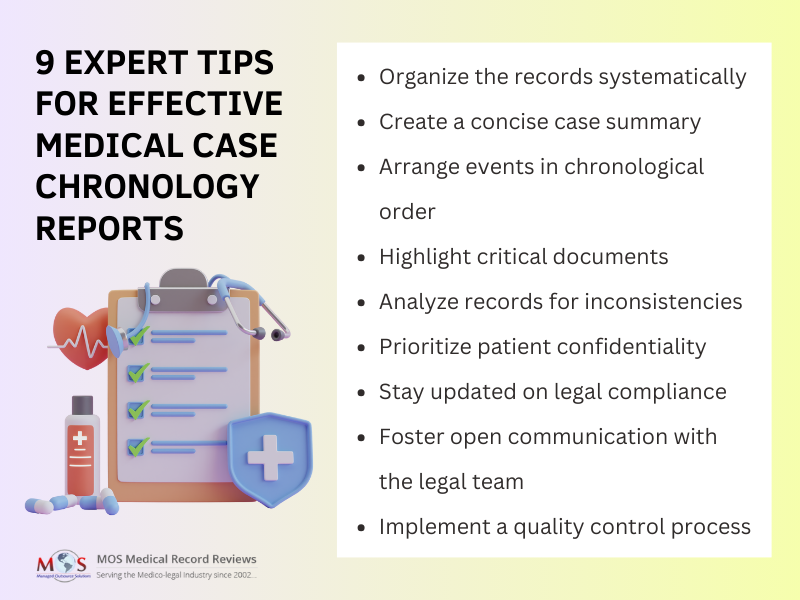Medical case chronology reports are comprehensive documents that contain a detailed account of a patient’s medical history and treatment journey. These reports include essential components such as the patient’s demographic information, an overview of their medical history, and a precisely organized chronological timeline of all medical encounters and procedures. Entries in the timeline detail the date of the encounter, healthcare provider information, diagnoses, treatment administered, and any associated complications or adverse events. Medical case chronology reports are indispensable tools that provide healthcare professionals, legal teams, and insurance companies a comprehensive understanding of the patient’s medical history and treatment, which is vital for informed decision-making.
Accurate Medical Chronologies Help Attorneys Develop Their Case Well
Attorneys require these reports for handling complex medical malpractice, personal injury, or workers’ compensation cases. With a reliable chronology made available, attorneys and their legal teams are saved the effort of reviewing and summarizing hundreds of medical records. Well-prepared case chronologies arm attorneys with all the medical aspects of the case, and this helps them prepare their case very well.
Ready to streamline your legal cases with precise medical chronologies?
Contact us today at (800)-670-2809
Benefits of Medical Chronology Reports in Legal Cases
Clear presentation of medical information: Chronology reports condense and present the relevant medical information in a clear, concise, and understandable manner.
Highlights key events: Well-prepared reports identify and highlight key medical events such as diagnoses, treatments, surgeries, and changes in medication, which helps build a timeline of the patient’s medical journey.
Establishes causation and liability: By analyzing the medical records, the report can demonstrate whether medical negligence or errors contributed to the patient’s condition or injuries, which is vital for determining liability and causation.
Supports expert testimonies: These reports provide a concise summary of the medical history, making it easier for medical experts to prepare their testimonies.
Helps calculate damages: In personal injury and medical malpractice cases, these reports help quantify the damages suffered by the plaintiff. The report provides a foundation for assessing financial compensation.
Objective documentation: Chronology reports provide an objective and organized overview of the patient’s medical history. This documentation can counter any attempts to manipulate or misinterpret medical information, ensuring that the facts are accurately represented.
Medical Case Chronology Preparation Tips
- Gather the medical records: Collect all relevant medical records, including physician notes, test results, imaging reports, discharge summaries, and any other pertinent documents.
- Organize the records chronologically: Arrange the medical records in chronological order, starting with the earliest available information and progressing to the most recent.
- Identify key events: Highlight important events in the patient’s medical history, such as the date of onset of the condition, hospital admissions, surgeries, treatments, and significant diagnostic findings.
- Record dates and details: Document the date of each medical encounter and provide a brief summary of the information contained in each record, noting any changes in the patient’s condition or treatment plan.
- Identify medical providers: Clearly indicate the healthcare professionals involved in the patient’s care, including their names, specialties, and affiliations.
- Summarize diagnoses and treatments: Include concise summaries of the diagnoses made and the treatments administered during each medical encounter, specifying any surgeries, medications, or therapies.
- Note complications or adverse events: If there were any complications, adverse events, or changes in the patient’s condition, make sure to document them alongside the relevant dates.
- Provide a medical history: Offer an overview of the patient’s medical history, including pre-existing conditions, allergies, and family medical history, to provide context for the chronology.
- Include imaging and test results: Incorporate radiology reports, laboratory test results, and diagnostic findings in the chronology, referencing the corresponding medical encounters.
- Compile a summary: Summarize the key findings and significant events in the patient’s medical history, making it easier for legal, medical, or administrative professionals to understand the case.
- Maintain confidentiality: Ensure that sensitive patient information is redacted or anonymized as required to protect patient privacy and comply with healthcare regulations.
- Update as necessary: Regularly update the medical case chronology as new medical records or information become available, to maintain its accuracy and relevance.
- Stringent quality control: This is a very important step to ensure that the reports prepared are error-free. Also, the quality control team makes sure that the information presented is complete in every respect. All discrepancies and errors are immediately corrected.
Check out our infographic on
How Medical Case Chronology Assists in Workers’ Compensation Cases
A major advantage of a well-prepared medical case chronology is that it reviews the relationships between the various medical events. For instance, it would look at how a particular treatment affected the patient’s condition, or how a particular diagnosis led to modifications in the treatment plan. This helps with obtaining a better understanding of the patient’s medical history. When the chronology is prepared by an experienced medical review company, they ensure that the report caters to the specific needs of each case.
Choosing the right medical record review company is crucial for law firms seeking accurate and comprehensive medical chronology reports. An experienced team of reviewers ensures accurate review of the medical records, highlighting crucial details, and crafting detailed chronologies. With professional support, legal teams can focus on building stronger cases, backed by well-organized and legally sound medical evidence.
Ensure the strength of your legal cases with our accurate medical chronologies.
Request a quote now and experience the difference.





